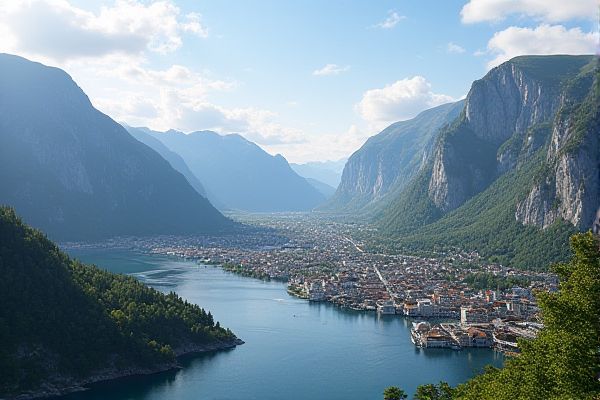
Transportation and commuting in Norway: Extensive public transportation network. Reliable train services. Electric vehicles highly encouraged. Efficient ferry system. Biking infrastructure well-developed. Walking is commonplace. Costly fuel prices. Toll roads in urban areas. Comprehensive bus services. High-speed rail connections.
Extensive public transportation network.
Norway boasts an extensive public transportation network, including well-developed road, rail, air, and water transport systems. The network is characterized by efficient public transport in cities, with integrated systems like Ruter in Oslo managing metro, trams, buses, and ferries, while buses and trains connect rural areas and major cities across the country.
Reliable train services.
Norway's train network, primarily operated by Vy, is renowned for its reliability and comfort, efficiently linking major cities such as Oslo, Bergen, and Trondheim. The trains provide spacious carriages and offer the option for sleeper trains on longer routes. Tickets can be conveniently purchased online or through the Vy app, with advance booking recommended for cheaper fares. For more details, visit the Lonely Planet website.
Electric vehicles highly encouraged.
Norway highly encourages the adoption of electric vehicles through a range of incentives, including exemptions from emissions taxes, VAT, and road taxes, as well as reduced parking fees, access to bus lanes, and free or reduced tolls and ferry crossings. These policies have led to over 60% of new vehicles sold in Norway being electric, with the country aiming for 100% of new passenger cars and light goods vehicles to be zero-emissions by 2025. To learn more about the specific measures implemented in Norway, visit the Norway's Electric Vehicle Incentives webpage on the International Energy Agency website.
Efficient ferry system.
Norway's ferry system, particularly operated by companies like Norled, is highly efficient, featuring a significant number of electric and hybrid ferries that reduce emissions, including the MF Hydra running on zero-emission liquid hydrogen. The routes such as Stokkvagen-Lovund-Traena cut emissions by up to 90 percent. This innovative system incorporates advanced charging infrastructure, like the rapid charging stations on the Hareid-Sulesund route, significantly reducing CO2 emissions by 7,000 tonnes annually. For more information, you can visit their website to explore how Norled is leading the way in sustainable maritime transportation.
Biking infrastructure well-developed.
Norway has a well-developed biking infrastructure, with a national cycling strategy aimed at making cycling safer and more attractive. The strategy includes creating a continuous cycle path network, prioritizing cycle traffic over cars, and ensuring safe and accessible cycling routes, particularly for short trips where half of all trips are under 5 km. To explore more about this comprehensive plan, you can view the National Cycling Strategy and delve into how Norway is transforming its urban landscapes to accommodate and encourage cycling as a primary mode of transportation.
Walking is commonplace.
Walking is a common mode of transportation in Norway, particularly in cities like Oslo, Bergen, Trondheim, Stavanger, and Tromso. These cities are designed to be highly walkable with traffic-free central areas, creating a pedestrian-friendly environment. Most attractions, restaurants, and hotels are conveniently located within walking distance, encouraging both locals and visitors to explore by foot. For more about walking in Norwegian cities, you can visit the 10000 Steps Guide which provides detailed insights and tips for exploring these vibrant urban locations on foot.
Costly fuel prices.
In Norway, fuel prices are relatively high, with current prices for Super 95 gasoline at EUR1.806 per liter, Premium 98 at EUR1.961 per liter, and diesel at EUR1.733 per liter. These prices have seen minor fluctuations recently but remain significant, impacting both household and commercial transportation costs. For more detailed information on these trends, you can visit the AutoTraveler website, a valuable resource for monitoring fuel price changes.
Toll roads in urban areas.
In Norway, urban areas such as Oslo have toll rings, including the Inner Ring, the Oslo Ring, and the City Border, where tolls are payable in both directions on the Inner and Oslo Rings, but only on the way into Oslo for the City Border. Tolls vary by vehicle weight and time of day, with higher tariffs during rush hours, and there are exemptions and discounts for certain vehicle types and payment methods. For more detailed information on these tariffs and toll stations, you can visit the Fjellinjen website.
Comprehensive bus services.
Norway's bus services are comprehensive, featuring frequent local buses in cities and an extensive network of express coaches connecting major towns, airports, and rural areas. Tickets can be bought in advance through apps or shops, and discounts are available for students, senior citizens, and families, with many routes offering scenic views and modern amenities like Wi-Fi and power outlets. To explore detailed information and plan your journey, you can refer to the official website, Visit Norway, which provides all necessary guidance for getting around by bus in this picturesque country.
High-speed rail connections.
In Norway, High-Speed Rail connections are limited, with the only current high-speed line being the Gardermobanen between Oslo and Eidsvoll, operating at up to 210 km/h. Plans are underway to develop new high-speed routes, including a proposed line from Oslo to Bergen, Stavanger, and Trondheim, aimed at significantly reducing travel times and enhancing rail connectivity across the country. For more information on these developments, you can visit the High-Speed Rail in Norway article. These initiatives highlight Norway's commitment to advancing its transportation infrastructure and promoting sustainable travel options.
